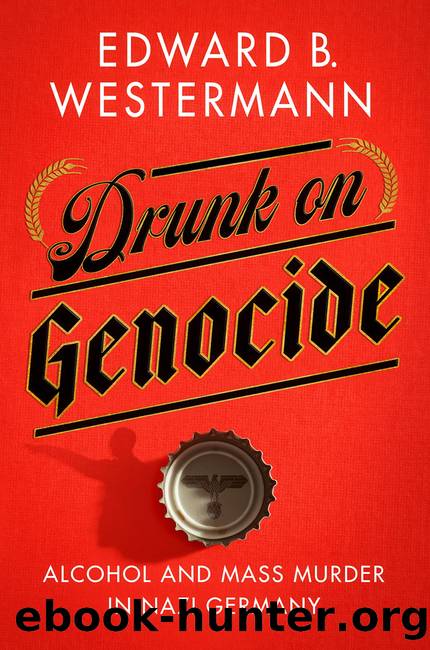Drunk on Genocide by Edward B. Westermann;

Author:Edward B. Westermann; [Westermann;, Edward B.]
Language: eng
Format: epub
ISBN: 9781501754203
Publisher: LightningSource
Published: 2020-11-24T00:00:00+00:00
Militarizing the Police
In the face of a Soviet winter counteroffensive and spiraling Wehrmacht losses, Hitler approved the formation of auxiliary police battalions at the end of January 1942, and SS and police leaders launched a major recruitment campaign the following month.62 In a speech to senior police leaders in February 1942, the chief of the German Order Police Kurt Daluege remarked that manpower shortages within the police by the end of 1941 required the creation of âauxiliary forces from the occupied territories . . . organized, trained, and equipped for the fulfillment of police tasks.â In the Reich Commissariat Ostland, auxiliary police forces drawn from among ethnic Latvians, Lithuanians, Estonians, and Belorussians numbered 31,652 men, almost ten times the size of German police forces in the region. Similarly, the Reich Commissariat Ukraine mobilized 14,452 police auxiliaries drawn from among ethnic Germans and Ukrainians in support of the areaâs 3,880 German uniformed policemen. Daluege praised the auxiliaries assigned to these companies and battalions for their efforts in the economic exploitation of the conquered territories and especially their performance in the ânever-ending battle against partisans, [Soviet] paratroopers, and communist criminals.â63
Daluegeâs comments offer several insights into the role and importance of the auxiliaries in the eastern campaign. First, German control over the occupied territories could hardly have been possible without the assistance of these forces. Indeed, auxiliaries formed the vast preponderance of total police forces in these areas. Second, Daluegeâs emphasis on the military organization of these forces, and especially their employment in anti-partisan operations, is a critical point. Already at the end of September 1941, a three-day conference on anti-partisan warfare, including representatives from the Wehrmacht, the SS, and the police, had been held at Mogilev in Belorussia. Guidelines prepared as part of the conference dictated that âthe enemy must be completely annihilatedâ and further argued, âThe constant decision between life and death for partisans and suspicious persons is difficult even for the hardest soldier. . . . He acts correctly who fights ruthlessly and mercilessly with complete disregard for any personal surge of emotion.â64 Not only did this conference establish annihilation as the standard for combating partisans, but it also introduced the equivalency of partisans with Bolsheviks and Jews. Indeed, Hitler equated Jews with partisans in a meeting with Himmler on December 18, 1941, that resulted in the latterâs telegraphic notation, âJewish question. [To be] exterminated as partisans.â65 In other words, as Daluege delivered his speech in February 1942, the terms âpartisansâ and âcommunist criminalsâ had already linked the mission of the police formations to the annihilation of the Jews.
Like their uniformed police counterparts, German Security Police units faced their own personnel crisis by early 1942 as they prosecuted a campaign of racial cleansing.66 As a result, the Reich Security Main Office issued orders on January 19, 1942, calling for the creation of auxiliary police battalions of the Security Police based on the existing model of the Order Police. These Security Police auxiliaries, like their uniformed police counterparts, were tasked primarily
Download
This site does not store any files on its server. We only index and link to content provided by other sites. Please contact the content providers to delete copyright contents if any and email us, we'll remove relevant links or contents immediately.
| Holocaust |
Cecilia; Or, Memoirs of an Heiress — Volume 1 by Fanny Burney(32029)
Cecilia; Or, Memoirs of an Heiress — Volume 3 by Fanny Burney(31441)
Cecilia; Or, Memoirs of an Heiress — Volume 2 by Fanny Burney(31391)
The Secret History by Donna Tartt(18105)
Sapiens: A Brief History of Humankind by Yuval Noah Harari(13960)
Leonardo da Vinci by Walter Isaacson(12773)
The Radium Girls by Kate Moore(11594)
Sapiens by Yuval Noah Harari(5111)
How Democracies Die by Steven Levitsky & Daniel Ziblatt(4945)
The Wind in My Hair by Masih Alinejad(4828)
Homo Deus: A Brief History of Tomorrow by Yuval Noah Harari(4675)
Endurance: Shackleton's Incredible Voyage by Alfred Lansing(4480)
The Silk Roads by Peter Frankopan(4253)
Man's Search for Meaning by Viktor Frankl(4237)
Millionaire: The Philanderer, Gambler, and Duelist Who Invented Modern Finance by Janet Gleeson(4072)
The Rape of Nanking by Iris Chang(4009)
Hitler in Los Angeles by Steven J. Ross(3791)
Joan of Arc by Mary Gordon(3771)
The Motorcycle Diaries by Ernesto Che Guevara(3767)
